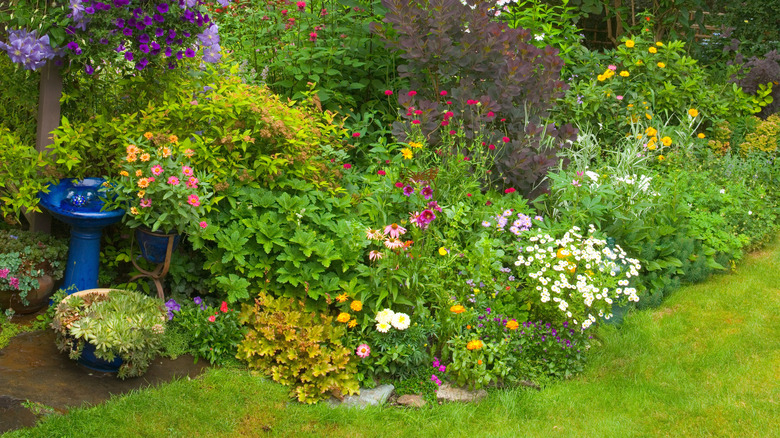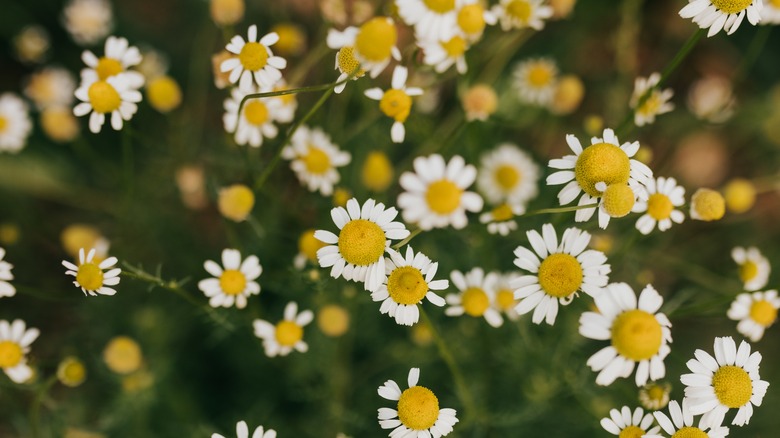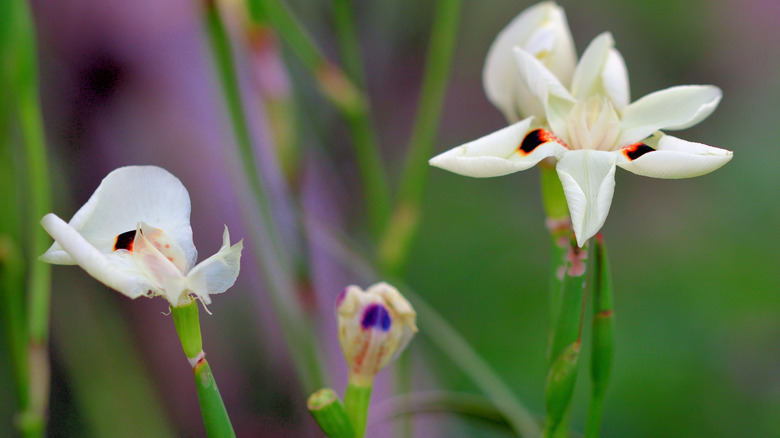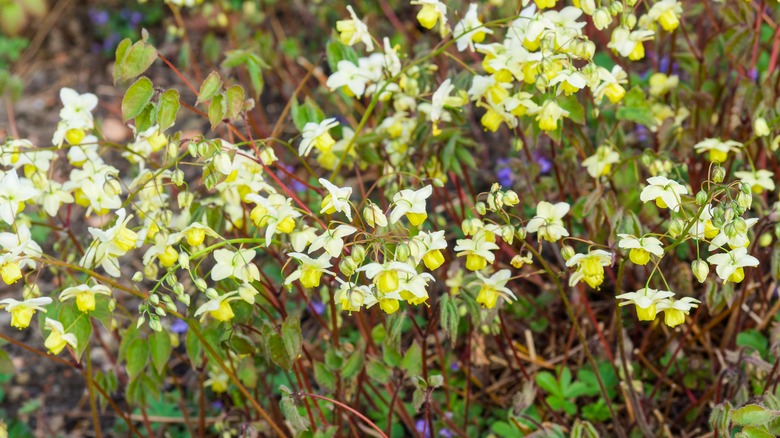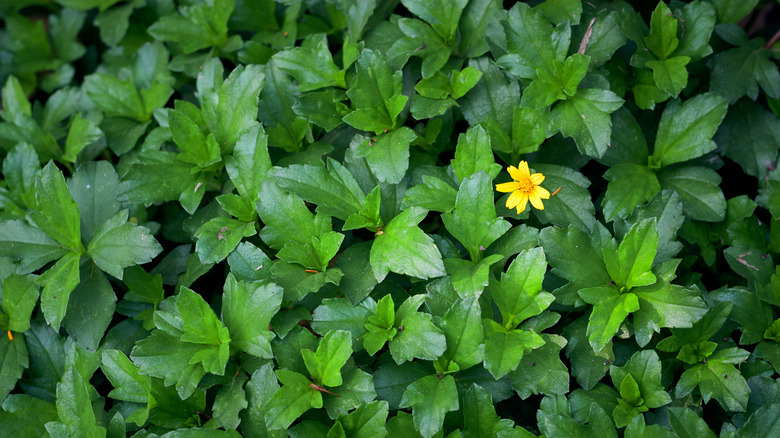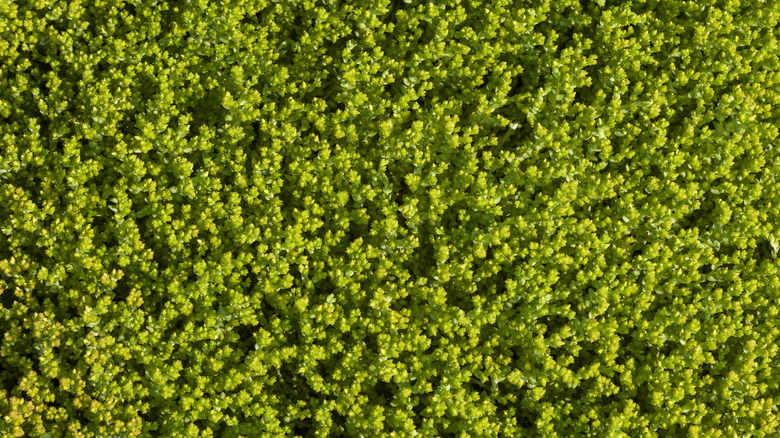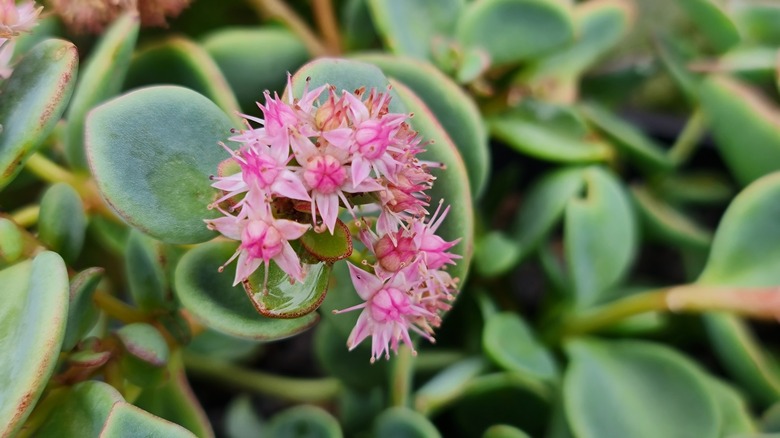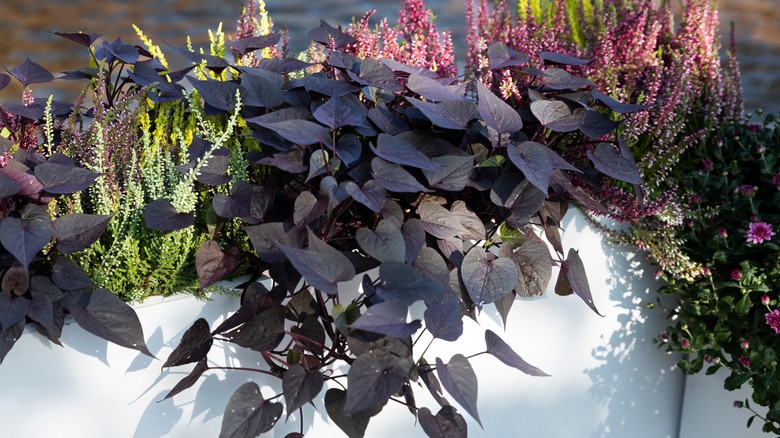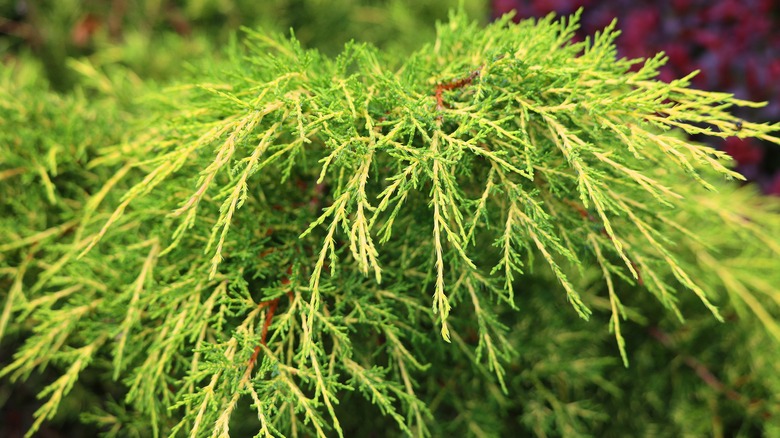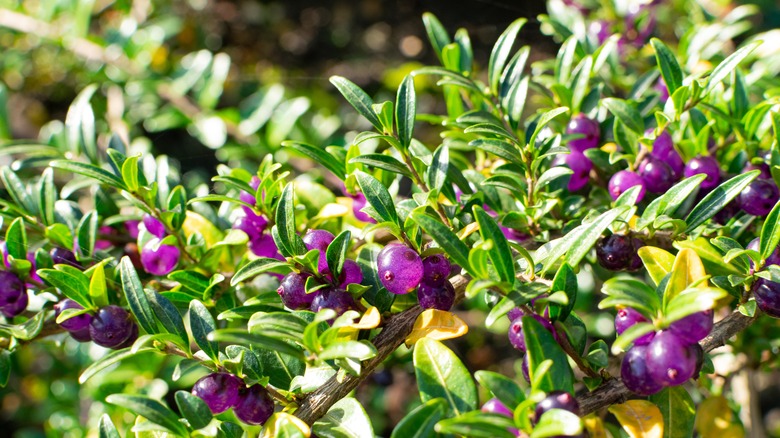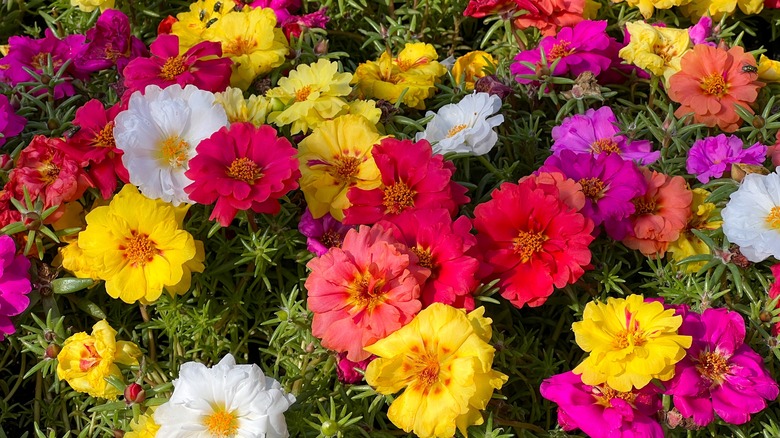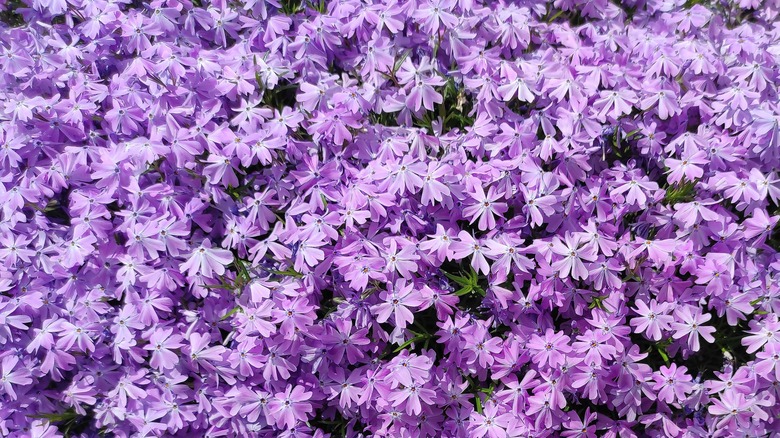Drought Tolerant Ground Covers You Can Easily Grow In Your Yard And Garden
Picture this: You're about to take that first sip of your morning coffee while looking out at your beautifully landscaped yard when suddenly you see it — brown patches in your lawn. What's worse is the realization that your morning coffee seems to be ruined more often, as your yard needs more water every year to handle the record-high summer temperatures, and some plants just aren't capable of withstanding the heat. Those dry, crunchy spots of grass and bare areas where nothing will grow, despite your best efforts, are enough to make you want to toss out your gardening tools and opt for some easier hobby, like neurosurgery or deep sea welding.
But don't chuck your cool collection of garden tools just yet, because we've got a solution. Instead of fighting dry, crispy grass, give one of these 11 drought-tolerant ground-covering plants a go. Drought-tolerant plants work by utilizing some pretty cool evolutionary traits that make them less reliant on you remembering to water them, like deeper roots that can search for moisture further below ground, muted leaf colors that don't use many resources to retain their color, leaves that can hold water for rough days, and the ability to shut down and go dormant during a prolonged drought period. What we love most about these plants is that they aren't just easy on the eyes; they'll also help conserve water with their drought-resistant capabilities and free up precious gardening time, thanks to their low maintenance care requirements. But wait, easy-to-grow plants that don't need a lot of water and aren't fussy — what's the catch? Well, your plant budget will need to get a little bit bigger to buy them, we suppose.
Roman chamomile makes a great problem-free ground cover
Roman chamomile (Chamaemelum nobile/Anthemis nobilis) is just awesome. Not only does it have a deep, calming aroma, but it's a workhorse plant that can help deter pests and even be used as a lawn replacement. Researchers found that chamomile flowers contain two compounds that may contribute to its drought tolerance: salicylic acid and methyl jasmonate. Despite its delicate appearance, chamaemelum nobile has a sturdy root foundation that spreads out in a creeping fashion, making it hardy enough to bounce back after the occasional mowing. However, it's not a big fan of foot traffic, so don't plant this somewhere that's a direct path for pets or kids; use it as a border plant for those paths instead.
To grow Roman chamomile as a ground cover, you'll need to start with at least 2 inches of space, but 4 inches gives it the best chance to spread quickly. Lawn substitutes need a little more room, about 6 to 12 inches between seedlings. Any variety will work fine as a basic ground cover, but if you're using it to replace grass, opt for the Treaneague cultivar. Treaneague chamomile is considered even lower maintenance, although it doesn't flower, which might be a dealbreaker for some. Chamaemelum nobile does best in well-draining soil that's a little sandy and can handle full sun or partial shade. Expect your chamomile flowers to bloom anywhere from summer to fall, and prune off spent blooms to prevent brown patches. While Roman chamomile is low maintenance, making it too happy can cause it to be aggressive if you're not paying attention, so cut back any growth that starts to get a little bossy.
Butterfly iris is a low maintenance but gorgeous ground cover
African iris, butterfly iris, fortnight lily — whatever you want to call it — you're sure to love as your new ground cover. Butterfly iris (Dietes iridioides) makes a fantastic option for USDA zones 9 through 11 as a perennial cover for patchy garden spots. Its ability to adapt to various soil conditions, including poor, gives it a hardiness that helps withstand periods of drought. Before blooming, the butterfly iris will look like clumps of long grass, but once you hit their bloom season, look out because you're about to be rewarded with paper-white petals that have splashes of striking colors.
To keep a butterfly iris happy, you'll need to plant it somewhere with well-draining soil that can stay a little moist and is full of organic materials that can nourish the plant. This plant can handle partial shade conditions, but if you want the full show, try to put it somewhere that gets full sun. Once it's established, you can neglect it a little, as butterfly irises have good drought tolerance, but try to keep the soil around them moist and well-fertilized. While it's hardy in the southern U.S., don't worry USDA Zone 1 through 8 gardeners — butterfly irises do just fine in containers, too, just bring it indoors once temperatures start to hit the 50 degrees Fahrenheit mark.
Fairy wings makes a dense ground cover that's great for under trees
Fairy wings (Epimedium x perralchicum) are easy, breezy ground covers that make perfect additions for those weird, shady spots in your yard or under trees. Epimediums originate from the Mediterranean and have used their ability to cope with the hot suns of their native habitats into a neat evolutionary trick that helps them navigate droughts. What makes fairy wings great, besides its name, is that it's a showstopper all year round. During the spring, happy buttercup-yellow flowers will bloom to welcome the warm weather. Once the blooms are spent, the dense foliage will turn green, eventually transitioning into a gorgeous bronze or copper color that makes it perfectly hued for fall.
Fairy wings are incredibly easygoing and hardy for USDA Zones 5a through 9b. They'll tolerate most types of soil, as long as they're well-draining, so make sure to aerate your soil if it's compact before planting these. Fairy wings won't do well in heavy sun and prefer to be somewhere with a little shade, which is why they're so popular as flowering ground covers to plant under trees. They also make fantastic ground covers that'll help prevent pesky weeds, thanks to their dense leaf mat, which blocks anything attempting to grow under it from getting the light it needs for photosynthesis.
Carpet daisy can be a lawn substitute, but needs some attention
The carpet daisy (Calyptocarpus vialis), sometimes called the straggler daisy or horseherb, is native to the southern U.S. and has a love/hate relationship with gardeners. Some love it because it's incredibly hardy, handling foot traffic and mowing so well that it's become a popular lawn alternative, even for moderate-traffic areas. Carpet daisy has a lot going for it: fast-growing, highly adaptable, and leaves covered with short, fine hairs — all of which can be powerful drought-resisting characteristics. Other gardeners, however, give it the side eye due to its tendency to become weedy and hard to kill. Do some serious soul-searching before deciding whether you want to use this plant because, while its cheerful yellow flowers sure are sweet, you're going to be seeing them for a long time, whether you like it or not.
Carpet daisies are drought-tolerant once they've settled in, but they'll need regular watering during their first spring and summer. In USDA zones 7a through 10b, you can expect this to be an evergreen plant, while zones 6b and below should anticipate it losing its leaves during the winter months. It will bloom throughout spring and into fall, attracting smaller species of butterflies. You can plant it anywhere, as this plant can tolerate most sun and soil conditions, but it's most popular for areas that have partial shade and soil that's a little sandy or loamy.
Carpet sedum can grow just about anywhere, including roofs
The sedum family of plants are succulents loved by indoor and outdoor plant parents thanks to their easygoing nature, vibrant color display, and ability to handle most living conditions. Carpet sedum (Sedum lineare), though, is a particular favorite for outdoor gardeners, because it's tough as nails. Its ability to grow fast and stores water in its leaves allows it to be both drought and heat tolerant, adaptable to living just about anywhere. It has a shallow root system, so it doesn't even need a lot of soil to grow, which is why it's used on building rooftops in Shanghai, creating green roofs that regulate temperature, purify the air, and increase the bustling city's biodiversity.
While carpet sedum isn't picky about where it lives, it's still a succulent, so it will need a spot that gets good sun coverage, or it will get leggy and less compact. In terms of where to plant it, any type of soil will work fine, even if it's rocky or nutrient-deficient. In fact, consider using this as a ground cover for weird spots in your yard that need a little foliage addition; carpet sedum is great at draping its mat-like growth over rocks, walls, fences, tree stumps — you name it.
Japanese stonecrop is a great ground cover for rocky terrains
If you want a show-stopping ground cover and live somewhere that can sustain succulents outdoors, look no further. Japanese stonecrop (Hylotelephium sieboldii) is part of the same family as sedums, Crassulaceae, making it another succulent that's hardy as a ground cover for gardeners who are jumping onto the xeriscaping trend to conserve water. Like other sedums, Japanese stonecrop can store water in its leaves to keep it going during times when water is scarce. Native to, you guessed it, Japan, it's a technicolor wonder year-round. During the spring months, expect blue-green leaves that look similar to a 'Blue dude' echeveria. As spring transitions into summer, the leaves start to show pink edges, giving you a tease of what's to come. Finally, during the fall, bursts of hot pink, orange, and red flowers burst through.
Japanese stonecrop needs soil that has very good drainage since it is prone to root and crown rot. Plant it somewhere that gets a lot of sun, as shady sites will make it look sad and floppy. Don't feel too jealous of your warmer-weather friends, northern gardeners; Japanese stonecrop works just as well as a potted succulent, as it does a ground cover. The same conditions apply: well-draining soil and lots of light.
Sweetpotato vine makes your goth garden dreams come true
Be still our cold, black hearts because the sweetpotato (Ipomoea batatas) is the goth ground cover we never knew we needed. Pay attention to the spelling, especially if you plan to buy this online, to ensure you get the right plant. Sweetpotato is a member of the morning glory family, not the nightshade family like its name-twin and distant cousin, the sweet potato (Solanum tuberosum). Despite it making our spooky hearts skip a beat, sweetpotato can actually be found in a variety of colors, from an almost day-glow green to the deepest purple-black. There are also several types of leaf shapes that range from the standard heart shape to something more akin to maple leaves. It's a fast-moving ground cover, growing up to 20 feet long, though most gardeners report their plant taps out around 10 feet. The vines will give off morning glory lookalike flowers and can produce edible tubers, though the ornamental cultivars are reportedly less tasty than the varieties grown specifically for food. Sweetpotato vines have extensive root systems that allow it to search further for water sources than other plants, making it an excellent choice for drought-prone areas.
Sweetpotato vines need well-draining soil that's loamy or sandy and consistently moist. Regardless of the color you pick, give it as much sun as you can to get the deepest hue and don't worry if its new growth starts off as green — it will darken over time. Unfortunately, while sweetpotato is drought-tolerant, it's not frost-tolerant and is only hardy in USDA Zones 9 through 11, so will need to either be dug up and brought inside or propagated by tuber cuttings in colder climates.
Creeping juniper is a highly adaptable ground cover
One of the reasons we love creeping juniper (Juniperus horizontalis) is because it's an easy plant that can do a lot with very little. Native to the northern U.S. and Canada, creeping juniper is a very adaptable ground cover with little branches that make it look like a miniature forest growing right in your garden. Those tiny trees also help it stay alive during periods of drought; some researchers believe the compact, dense nature of their leaf growth pattern gives it a key advantage in retaining moisture and using whatever water it's got efficiently. Most varieties have a blue-green shade to their leaves that fades into a muted purple-bronze hue during the winter months, making them a beautiful ground cover year-round. Plus, they can grow up to 10 feet wide, so if you need to cover a lot of yard and don't want to fuss around with too many plants, creeping juniper can do a lot of the heavy lifting for you.
If you decide to add creeping juniper to your yard, our best advice is to plan ahead and expect the best. Since it's hardy and adaptable, you most likely won't kill it easily, so give it a wide berth of anywhere from 6 to 12 feet of space per plant. While it can handle some shade, creeping juniper does best in full sun setups and well-draining soil. As for the rest, like soil pH levels and compositions, it really doesn't care as long as there's good drainage.
Box leaf honeysuckle spreads slowly, but is worth the wait
The box leaf honeysuckle (Lonicera pileata) is a fantastic option for gardeners who want a ground cover, but not just yet. It's a shrub that stays low and spreads slowly, conserving moisture to prevent stress from a lack of water, which gives it a competitive advantage in drought-prone areas. It produces iconic white honeysuckle blooms and some unique translucent deep purple berries that are welcomed food for birds in the winter. But don't mistake its slow growth as a lack of enthusiasm, because this shrub can spread, covering up to 8 feet when fully matured. So, if you're slowly transitioning an area and will need ground-covering plants eventually, but not today, the box leaf honeysuckle should be a serious contender.
Box leafs are hardy in USDA zones 6a to 8b, as long as they have well-draining soil, and will need less maintenance if it gets a little shade. It can handle full sun, but you'll need to water it more frequently. One tip: Pay attention to the type of Lonicera you're buying, as some species are considered invasive.
Use moss rose for adding a little drama to your landscape
Many of the ground covers we've, uh, covered are considered mostly evergreen, but what if you want something a little less permanent? Enter moss rose (Portulaca grandiflora), the ground cover here for a good time and not a long time. Native to South America, moss roses are annuals that burst a rainbow of colorful blooms on sunny days. On cloudy or rainy days, they prefer to pout like the drama llamas they are, closing up shop and waiting for sunnier days ahead. Moss rose is not quite a succulent, but it has enough succulent qualities that it's close enough; it stores water in its leaves and stems, so it can handle neglect and drought like a champ. If you've struggled to keep things alive in spots where the temperatures are hot and the soil is dry, pop a moss rose there and see what happens.
While moss roses love a challenging growth spot, they'll give you the most dramatic flower display if the soil is somewhat nutrient-rich and kept at least a little moist. They love full sun and will self-seed easily, but not to the point where it becomes invasive. Moss roses also do well in containers or hanging baskets, and look incredible cascading down a wall or trellis.
Creeping phlox is a hardy and easygoing ground cover
Sometimes, you just want to keep it simple and stick with a tried-and-true winner. Enter creeping phlox, a drought-resistant ground cover that can spread up to 3 feet with dozens of beautiful blooms. What's interesting about creeping phlox is that they seem to have developed unique combinations of amino acids and other compounds that make its cells more adaptable, changing its physiology to maintain the status quo during drought conditions. There are a few types of creeping phloxes, so it's easy to get confused about which one to pick, so here's a quick cheat sheet: Option one is Phlox stolonifera, an evergreen ground cover that grows fast and does best with a little shade. Its flowers are bigger than subulata's, both in width and height, reaching as high as 12 inches above the mat. P. stolonifera is the later bloomer, pushing flowers out in late summer to early fall, and is hardy in USDA zones 5 through 9. It will grow best in soil that's got a little humus, is consistently moist, and slightly acidic.
Option two is Phlox subulata, which is semi-evergreen and grows slower than stolonifera. However, its smaller flowers bloom right at the height of spring and can handle full sun and hot temperatures with no problem. Plus, there's power in being small but mighty; P. subulata's blooms only reach as high as 6 inches tall, making this variety a better option for spots that get mowed. It's hardy in USDA zones 3 through 9 and likes soil that's got a little grit to it, can stay moist, and is well-draining.
So, if you want a ground cover that grows fast and can be patient for the flower show, go for P. stolonifera. However, if you want a ground cover with a fast flower display to get you out of those winter doldrums and have a spot with lots of sun and heat, P. subulata is the better pick.
